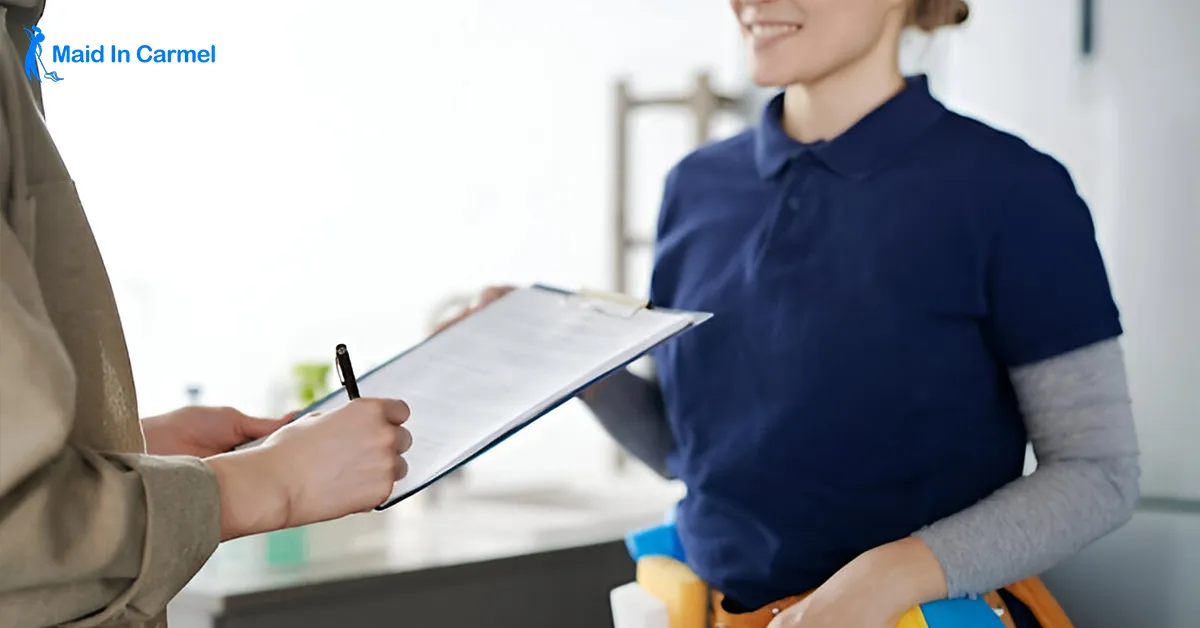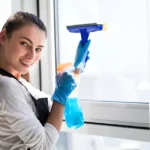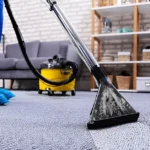Organizations must use cleaning checklists to sustain a hygienic, fresh setting inside their facilities. A methodical cleaning schedule will both improve building inhabitants’ welfare and increase workplace productivity. This guide delivers an extensive introduction to janitorial cleaning standards, which includes full explanations about office franchises as well as restroom care and intensive service details.
Any commercial workplace needs clean procedures for janitorial duties to maintain environmental cleanliness. A properly organized cleaning program simultaneously improves facility visuals while creating better conditions for people who work or visit there. This entire guide includes complete checklists that enable you to sustain hygiene standards throughout your facilities so that everyone experiences healthier work environments.
The Importance of Professional Janitorial Services
Professional janitorial services grant your installation benefits that extend beyond mere visual enhancements. The periodic maintenance, along with routine cleaning procedures, creates a protective environment through the removal of both dust and allergens and disease-carrying germs that cause illnesses to building inhabitants. Workplaces that maintain cleanliness produce fewer sick cases and achieve better overall productivity results among their staff. The guide titled Modern Office Cleaning provides detailed information about environmental integrity preservation.
Facilities in proper upkeep produce positive initial perceptions when visitors, clients, and business affiliates enter the building. Your workspace appearance gives visibility to your company’s ability for detailed work and dedication to professional excellence. By investing in professional cleaning services, you extend the operational life of building elements such as ceiling tiles and walls because professionals use appropriate methods to protect your investments and delay expensive replacement costs.
Essential Areas in Office Cleaning
The process of effective office cleaning focuses primarily on those spaces that affect both the physical appeal and workplace health conditions. The cleaning process should concentrate on reception rooms, together with work surfaces and public zones, extending to hallways and break areas. The proper execution of cleaning protocols needs to be maintained in offices since they ensure both professional appearance and occupant health protection. Routine maintenance controls the accumulation of dirt and germs that lead to decreased workplace productivity, alongside poor visitor perceptions.
Reception and Common Areas
The facility’s entrance points, along with reception areas, implement essential first-time impressions. The cleaning of busy focus points within your office building needs distinct attention.
- Crew members should perform daily garbage bag replacement while emptying them.
- You should thoroughly vacuum carpets, together with a thorough floor sweep.
- Dust furniture, fixtures, and decorative items
- The cleaning of glass surfaces must include removing fingerprints from all entrances and windows.
- Cleaning staff should sanitize all contact surfaces, which include door handles.
- You should use appropriate cleaning products to polish, along with cleaning reception furniture and desks.
Airborne particulates gather heavily at all entrance points where people enter and exit the building. A department entrance cleaning checklist requires manual removal of outdoor debris from walkways and subsequent floor mat cleaning methods and finishing steps to achieve professional entryways. More information about handling these specific areas comes from our Restroom Cleaning Techniques page, which shows universal approaches for controlling high-traffic zones.
Workplace Sanitization Essentials
Workers in office environments face exposure to many bacteria and germs because staff constantly handle shared surfaces. The workplace sanitization operations must consist of the following total procedure:
- Cleaning the phone alongside keyboard devices and a computer mouse requires a disinfecting process.
- Workplace personnel need to perform routine cleaning combined with disinfecting procedures on desktops as well as work surfaces.
- Staff members should sanitize chair armrests along with other surfaces that people touch routinely.
- Emptying personal trash bins
- Efforts to clean targeted wall areas while also removing fingerprints should be included in the routine.
- Workplace staff must sanitize all shared equipment, which includes printers and copiers.
Boosting workplace sanitization practices throughout the cold and flu period leads to reduced transmission of illnesses among employees. Different cleaning solutions should be used to maintain proper disinfection processes while preserving the value of important equipment. Users can find detailed information about proper sanitization techniques by referring to our guide on workplace sanitization.
Dusting and Vacuuming Procedures
The presence of dust generates both visual unattractiveness in addition to producing allergic reactions and respiratory disturbances. The complete process of dusting and vacuuming should follow the following steps:
- Staff members must clean downward from the highest to the lowest positions (starting high at the ceiling and ending at the floor).
- Microfiber cloths should be used to collect dust particles instead of redistributing them as contaminants.
- Paying special attention to vents, ceiling fans, and light fixtures
- Workers should relocate items of furniture to vacuum areas of the floor underneath them whenever possible.
- Professional attachments should be selected based on the floor type.
- Vacuuming carpets with overlapping strokes
The best approach to maintaining air quality includes dusting first because it allows vacuuming to trap airborne particles released from dusting. Cleaning equipment featuring HEPA filters possesses the capacity to collect an increased number of particles, which results in superior indoor air quality. To understand the complete process of keeping air quality high with dusting and vacuuming, refer to our full explanation guide.
Comprehensive Restroom Maintenance Services
All facilities need the most demanding cleaning procedures for their bathrooms and restroom areas. Microbiologic contamination along with uncleanliness in this space strongly affects how visitors and employees perceive the location.
Daily Restroom Cleaning Tasks
Every daily restroom cleaning schedule must consist of the following tasks:
- Operational supply maintenance includes filling paper towels as well as toilet rolls and providing fresh hand soap.
- Thoroughly disinfecting toilets and urinals
- Workers should clean and polish the reflective surfaces and glass surfaces.
- Employees should sanitize all surfaces on countertops as well as handles and faucets together.
- The team should clean partition walls while also getting rid of visible moisture stains.
- The cleaning staff executes floor disinfecting procedures by using a mop and sweeping system.
- The staff must empty trash bins as well as conduct new liner installations.
Color-coded cleaning tools prevent bacteria spread between different rooms of a public bathroom. The use of toilet cloths must always remain restricted to their designated toilet function while being prohibited from touching countertops or door handles. Users can find advanced restroom maintenance guidance on our specific webpage.
Weekly Deep Cleaning of Restrooms
Weekly deep cleaning performed on restrooms enhances their cleanliness as part of weekly tasks.
- A process to clean mineral formations from toilets and urinals provides optimal results.
- Deep cleaning grout lines and tile surfaces
- Polishing all metal fixtures
- Cleaning walls and partitions thoroughly
- The maintenance team needs to check along with cleaning all vents and air ducts as part of their duties.
- Keeping space behind toilets along with challenging-to-access areas should be sanitized.
The monthly duties entail vent inspection and cleaning, as well as wall washing, along with absorbent checking to prevent significant issues from occurring. The complete deep-cleaning techniques are described fully in our complete guide.
Floor & Carpet Cleaning Services Guide
Any facility has its largest exposed area in flooring and requires consistent care to protect both appearance and operational performance.
Different Flooring Types and Care
A particular cleaning method suits each hard floor type, including tile flooring, vinyl tiles, and hardwood planks.
- Cleaning tile surfaces requires appropriate solutions for regular mopping, and professionals should clean grout lines periodically.
- Caring for vinyl linoleum floors requires dust mopping and subsequent damp mopping using mild cleaning solutions.
- To clean hardwood, one must use specialized wood cleaners while preventing too much moisture exposure.
- Natural stone: pH-neutral cleaners and periodic sealing
A proper methodological examination is necessary to properly care for carpets.
- Daily vacuuming of high-traffic areas
- Weekly complete vacuuming
- Prompt spot treatment of spills
- Quarterly deep cleaning by hot water extraction
- Annual professional deep cleaning and protection
Schedules for cleaning operations will need adjustment based on the specific traffic patterns and environmental scenarios of each space. The production environment needs increased floor cleaning due to production waste and safety hazards concerns. The facility can benefit from specific floor and carpet cleaning approaches that match its requirements.
Trash Removal Best Practices
The correct disposal of waste materials represents a vital janitorial service element frequently disregarded by building owners.
- Empty all trash receptacles daily
- Regular cleaning and sanitation of waste receptacles should happen to stop unpleasant smells.
- Replace liners consistently
- Ensure proper separation of recyclables
- Consolidate waste for efficient removal
- Follow local regulations for disposal
- Every waste collection area must remain neat and organized.
Approximately two hours of trash removal should be scheduled for food service areas and others with significant organic waste, respectively, to avoid mold growth and pest intrusion. An official waste disposal policy provides consistent waste management that remains compliant with environmental standards. The resource page presents details on successful trash removal strategies.
Deep Cleaning Services: Beyond Regular Maintenance
Deep cleaning sessions focus on removing heavy soil and dust from places that are difficult to reach, instead of fundamental surface cleaning.
When to Schedule Deep Cleaning
Consider scheduling deep cleaning:
- Quarterly for most office environments
Before and after major events - During low-occupancy periods like holidays
- The building needs seasonal cleaning activities because atmospheric conditions alter over time (spring pollen and winter salt residue).
- After renovations or construction
The deep cleaning process allows facilities to maintain their baseline hygiene level by resolving confined issues that could transform into visible health or appearance complications. A complete guide about deep cleaning services exists in our publication.
Deep Cleaning Procedures for Modern Office Cleaning
Performing a deep cleaning in a modern office facility demands the following series of tasks:
- Empty areas under furniture need cleaning, together with spaces that are hard to reach.
- Staff members should extract trapped soil from both carpets and upholstery materials.
- The process includes cleaning light fixtures while also following necessary bulb replacements.
- Washing blinds and window treatments
- The maintenance team should perform complete cleansing operations on ventilation grills, together with their returns.
- Sanitizing keyboards and office equipment
- The process includes sanitizing storage units along with other interior spaces in cabinets.
- Cleaning the interior glass components and partitions will be performed as part of the service.
The current practice in office cleaning aims to deliver health-promoting spaces by enhancing ventilation quality and reducing material toxins to benefit people who occupy these spaces and protect environmental ecosystems. Read about the modern approaches used in office cleaning operations.
Specialized Cleaning for Manufacturing Environments
The combination of production operations and production equipment, along with facility safety protocols, produces distinctive clean-up issues that facilities must manage.
Specialized cleaning considerations include:
- Addressing industrial dust and debris
- You must cleanthe equipment as per manufacturer-created specifications.
- Following safety protocols around machinery
- Appropriate cleaning agents must be selected to clean the industrial soils.
- Clear maintenance of emergency exits, together with safety pathways, must always be implemented
- Exercise proper care with oil substances and industrial fluids, together with lubricants.
- Regular cleaning of vertical structures and high elevations on rafters must be performed.
The manufacturing process benefits when cleaning schedules are developed to match production halt periods. Proper scheduling of cleaning operations creates the best outcome for effectiveness, preserves operational productivity, and fulfills safety needs. A specialized guide exists for those who wish to learn more about manufacturing environment cleaning.
Commercial Cleaning Services: Choosing the Right Provider
A correctly chosen commercial cleaning service will deliver the proper maintenance your facility requires:
- Verify experience with similar facilities
- Check references and reviews
- Confirm insurance and bonding
- Enhanced monitoring of employee training processes, together with screening procedures, should be completed
- Discuss communication protocols
- Understand quality control measures
- Examine their equipment and technology
- Evaluate their environmental practices
The assessment process conducted by professional commercial cleaning services allows them to craft individualized cleaning operation designs that optimize their service delivery without using generalized solutions, which may overlook essential zones. To learn more about commercial cleaning services, refer to our specific page.
Implementing Your Janitorial Cleaning Checklist
A complete checklist generates the best results only when it receives proper implementation while being actively maintained.
- Every cleaning staff member requires complete training about the established procedures.
- Detailed checklists need to be established for each area under service.
- Implement quality inspection procedures
- Organizations need to create defined pathways that enable staff to report concerns.
- Constant evaluation and update procedures must be performed on cleaning protocols.
- A regular check of cleaning frequency occurs when seasons change or facility usage patterns shift.
- Document special cleaning needs
- Every facility should keep track of its inventory supply, including equipment.
The implementation of checklists becomes more efficient through digital applications for checklist management and scheduling, and quality control tracking programs. Such tools guarantee consistent cleaning while generating records of completed work that management can assess.
Conclusion!
A properly designed checklist for janitorial services establishes the base, which allows employees and business visitors to maintain clean and healthy areas. Establishing structured cleaning protocols for all facility zones, including bathrooms, workplaces, and manufacturing zones, will generate a space that supports staff health and office productivity, along with professional growth.
Your facility needs a cleaning makeover to produce a healthier environment. Maid In Carmel acknowledges the significance of an all-encompassing cleaning strategy for both clients and employees. Start using these janitorial checklists now to experience positive changes in both your areas and their users.
Our resources detail full-scale how we assist businesses through our janitorial cleaning services, which allow experts to construct custom cleaning solutions for each organization.




